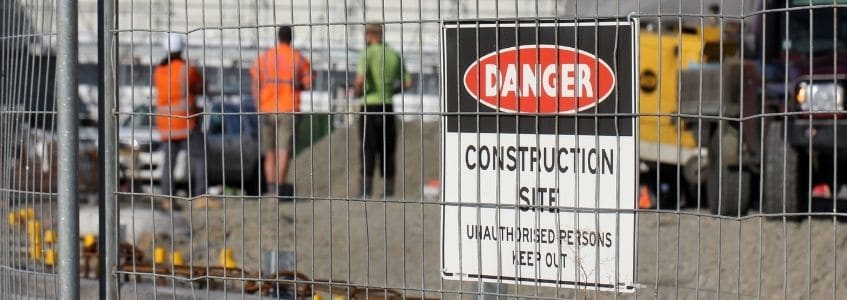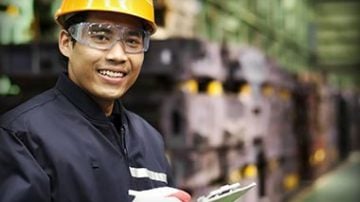For roofing contractors, there's one aspect of any project that should always be at the forefront: safety. Roofing contractors operate in an industry where the stakes are high, and ensuring the well-being of workers and compliance with safety regulations is vital.
Roofing is a profession that demands precision, skill, and an unwavering commitment to safety. The nature of the work often involves working at heights, exposure to various hazards, and navigating complex regulations. Whether you're a seasoned contractor looking to reinforce your safety protocols or a new contractor to the roofing industry, these roof safety tips will be the linchpin of successful roofing endeavors.
The Roofing Industry and Its Safety Challenges
The roofing industry holds a special role in the vast landscape of construction. As the element that provides shelter and protection to buildings, roofs are not merely structural components; they are the first line of defense against the elements. This significance places roofing contractors at the forefront of construction projects, ensuring that every structure is shielded from rain, snow, wind, and more. Roofing work spans residential, commercial, and industrial settings, making it a versatile and in-demand field.
Common Safety Challenges in Roofing
Roofing contractors face a unique set of hazards that require careful attention and mitigation. Some of the most prevalent safety challenges include:
- Working at Heights: Roofing often involves laboring at significant heights, increasing the risk of falls. Even a momentary lapse in attention can lead to severe accidents.
- Weather Sensitivity: Roofers are exposed to the elements, making them vulnerable to slippery surfaces during rain or snow, or heat-related illnesses during scorching summers.
- Material Handling: Roofing materials, including heavy shingles and equipment, need to be moved and handled carefully to prevent injuries.
- Tool and Equipment Safety: Proper use and maintenance of tools and equipment are vital to prevent accidents or malfunctions.
- Ventilation and Hazardous Materials: In some cases, roofing work involves dealing with hazardous materials like asbestos, and ensuring proper ventilation is essential.
The Risks of Roofing Work
Roofing projects carry inherent risks due to these noted challenges. Falls from heights are a leading cause of construction fatalities, and roofing work contributes significantly to these statistics. Weather conditions can make surfaces slippery, increasing the likelihood of accidents. The handling of heavy materials poses a risk of musculoskeletal injuries, and improper ventilation or exposure to hazardous materials can lead to long-term health problems.
Ensuring Safety through Roofing Industry Regulations
Compliance with industry regulations is not optional; it's a legal requirement. Failure to adhere to these standards can result in serious consequences, including fines and, more importantly, an increased risk of workplace accidents. Roofing contractors must prioritize safety by familiarizing themselves with these regulations and implementing measures to ensure full compliance.
Recognizing the unique challenges posed by roofing work, there are established specific regulations and guidelines tailored to the roofing industry. These regulations are designed to address the prominent safety concerns that roofing contractors face daily.
Fall Protection
Falls from elevated surfaces are a significant hazard in roofing work. To mitigate this risk, the industry fall protection standard mandates that roofing contractors must provide fall protection systems for employees working on roofs with unprotected sides and edges, leading edges, and holes. This standard encompasses guardrail systems, safety net systems, personal fall arrest systems, and positioning device systems.
Fall Protection Measures
Guardrails, Safety Nets, and Personal Protective Equipment (PPE)
- Guardrails: One of the most effective passive fall protection measures, guardrails are physical barriers installed along the edges of roofs or elevated work areas. They act as a protective shield, preventing accidental falls. Properly installed guardrails offer peace of mind to workers, knowing they have a solid barrier between them and the edge.
- Safety Nets: Safety nets are another valuable tool in the fight against falls. When installed correctly, safety nets can catch and absorb the energy of a falling worker, reducing the impact and potential injury. These nets are particularly useful when guardrails or other passive measures may not be feasible.
- Personal Protective Equipment (PPE): PPE for fall protection includes harnesses, lanyards, and anchors. Harnesses securely fit around a worker's body and distribute the force of a fall across the strongest parts, reducing the risk of injury. Lanyards connect to the harness and are anchored to a secure point. In the event of a fall, the lanyard arrests the worker's descent.
Implementing Effective Fall Protection Strategies
- Training: Ensure that all workers receive comprehensive training on fall protection measures. They should understand how to properly use PPE, install guardrails, and work near safety nets.
- Regular Inspections: Routinely inspect fall protection systems, including guardrails, safety nets, and PPE, to ensure they are in good condition. Damaged equipment should be immediately replaced.
- Anchorage Points: Identify and establish suitable anchorage points for fall protection systems. These points must be strong enough to support the forces generated during a fall.
- Supervision: Assign competent personnel to supervise work at heights. Supervisors should have a thorough understanding of fall protection measures and be vigilant in enforcing safety protocols.
- Emergency Response: Develop and communicate emergency response plans for fall incidents. Ensure that all workers know what to do in case of a fall, including how to initiate rescue procedures.
Ladder Safety
Ladders are indispensable tools in roofing projects. The industry ladder safety standard outlines requirements for the safe use of portable ladders. It covers aspects such as ladder design, weight capacity, proper placement, and securing ladders to prevent accidents. Proper ladder usage is essential for preventing falls and injuries.
Choosing the Right Ladder
- Consider Task Requirements: The ladder's height and type should match the specific requirements of the task. For instance, a simple step ladder might be sufficient for minor repairs, while larger extension ladders may be needed for more extensive projects.
- Weight Capacity: Ensure that the ladder has an adequate weight capacity to support the worker and any equipment or materials they need to carry.
- Material Matters: Ladders are available in various materials, including aluminum and fiberglass. Consider factors like weight, durability, and electrical conductivity when choosing the right material.
- Inspect for Damage: Before each use, inspect the ladder for any visible damage, such as bent rungs or rails, loose hardware, or cracks. If you find any issues, take the ladder out of service until repairs are made.
Safe Setup and Usage Techniques
- Stability: Place the ladder on a stable and level surface, and ensure that it won't shift during use. Use ladder levelers or stabilizers if needed.
- Angle Matters: The ladder should be set at an angle where the base is one foot away from the structure for every four feet of ladder height.
- Three-Point Contact: Maintain three points of contact (two hands and one foot or two feet and one hand) when climbing or descending a ladder.
- Tool Belt Use: Avoid carrying tools or materials in your hands while on the ladder. Use a tool belt or hoist equipment up after you've safely ascended.
- No Overreaching: Keep your body centered between the ladder's side rails, and never overreach. Descend and move the ladder if you can't reach your work comfortably.
- One Person at a Time: Ladders are designed for one person at a time. Avoid doubling up or carrying passengers.
- Descend Carefully: Don't rush when descending the ladder. Maintain a firm grip, and face the ladder as you step down.
Ladder safety is everyone's responsibility on the job site. Roofing contractors must provide proper training to their workers, ensuring they understand the importance of ladder safety and how to use ladders correctly. Additionally, routine inspections and maintenance of ladders are crucial to preventing accidents.
Hazard Communication
Roofing contractors frequently deal with hazardous materials like adhesives, coatings, and roofing cement. The industry hazard communication standard requires employers to implement a comprehensive program for communicating information about chemical hazards to employees. This includes proper labeling, safety data sheets, and employee training on handling hazardous materials safely.
Hazard Communication Measures
- Potential Risks: Workers can identify the risks associated with specific chemicals or materials, such as flammability, toxicity, or reactivity.
- Safe Handling Procedures: They learn how to safely store, use, and dispose of these materials to minimize risks. Safe handling practices also include the proper labeling of hazardous materials.
- Emergency Response: In case of accidents or spills, workers know how to respond quickly and effectively to mitigate the impact.
Material Safety Data Sheets (MSDS)
At the heart of hazard communication are Material Safety Data Sheets (MSDS), which are now known as Safety Data Sheets (SDS) under the Globally Harmonized System of Classification and Labeling of Chemicals (GHS). MSDS/SDS serves as a comprehensive source of information about hazardous chemicals and materials.
Key information found on an MSDS/SDS includes:
- Chemical Composition: Lists the chemical ingredients and their concentration in the product.
- Physical Properties: Describes the substance's appearance, odor, and physical state (e.g., liquid or solid).
- Health Hazards: Provides information on potential health effects, including symptoms of exposure and first-aid measures.
- Fire and Explosion Data: Details the substance's flammability and reactivity, as well as fire fighting measures.
- Safe Handling: Offers guidance on safe storage, handling, and disposal procedures.
- Emergency Procedures: Outlines steps to take in case of spills, leaks, fires, or accidents involving the material.
Roof Contractors Safety Training and Education
Roofing workers are well aware that each day on the job brings unique challenges and potential risks. That's why ongoing training and education are invaluable tools in creating a culture of safety and ensuring that everyone returns home safely after a day's work.
Ongoing Training and Education
- Stay Informed: The construction industry, including roofing, evolves. New materials, technologies, and safety practices emerge regularly. Ongoing training helps contractors and workers stay informed about the latest developments, ensuring they're always working with the best and safest methods.
- Reduce Accidents: The old adage, "knowledge is power," rings true in the roofing world. The better-educated roofing contractors and their teams are, the more they can identify and mitigate risks. This directly translates to a lower accident rate, fewer injuries, and fewer insurance claims.
- Legal Compliance: Roofing contractors must adhere to various state and federal regulations. Regular training sessions ensure that everyone understands and complies with these legal requirements, avoiding costly fines and legal issues.
- Boost Morale: Investing in the safety and education of your employees shows that you care about their well-being. This boost in morale often results in a more committed and motivated workforce.
Benefits of Safety Training Programs
- Standardization: Safety training ensures that everyone on the team understands and follows the same safety protocols. This standardization reduces the likelihood of confusion or miscommunication on the job site.
- Risk Mitigation: By focusing on potential risks, training programs empower workers to identify and address hazards before they become accidents. This proactive approach significantly reduces the chances of workplace injuries.
- Improved Efficiency: Properly trained workers are more efficient because they know how to use tools and equipment correctly. This not only enhances productivity but also reduces the wear and tear on equipment, leading to cost savings.
- Emergency Response: In the event of an accident or emergency, trained workers can respond swiftly and effectively. This can be the difference between a minor incident and a major catastrophe.
Safety Training Topics for Roofing Work
- Fall Protection: Given that working at heights is a constant in roofing, fall protection is paramount. Training should cover the proper use of harnesses, lifelines, guardrails, and safety nets.
- Ladder Safety: Roofing often requires workers to access elevated areas. Training on ladder safety should encompass ladder selection, setup, and safe climbing techniques.
- Weather Considerations: Roofers must work in various weather conditions. Training should address the risks of working in rain, snow, or extreme heat and how to mitigate these risks.
- Hazard Communication: Roofing materials can include hazardous substances. Training should educate workers on identifying, handling, and disposing of such materials safely.
- Tool and Equipment Safety: Roofing contractors rely on various tools and equipment. Training should emphasize the proper use, maintenance, and safety precautions related to these tools.
Roof Contractor Safety Plans
A critical component of safety training is the development and implementation of roof safety plans. These plans serve as roadmaps for identifying and mitigating risks specific to each roofing project.
- Risk Assessment: Identifying potential hazards and assessing their severity.
- Safety Measures: Outlining safety protocols and measures to prevent accidents.
- Emergency Response: Detailing procedures for responding to accidents, injuries, or other emergencies.
- Communication: Establishing clear lines of communication between workers and supervisors regarding safety concerns.
- Training Requirements: Defining the training needed for specific roofing tasks and ensuring that all workers are adequately trained.
The Value of Collaborating with a Safety Consultant
Safety training and education are investments in both the well-being of workers and the success of roofing projects. Roofing contractors who prioritize safety through ongoing training not only reduce the potential for accidents but also build a reputation for reliability and professionalism in an industry where safety is paramount. Whether you're a seasoned construction professional or a contractor just starting, the value of working with a safety consultant cannot be overstated.
Benefits of Working with a Safety Consultant
- Expert Guidance in a Complex Landscape
- Tailored Solutions for Your Unique Needs
- Accident Prevention and Risk Mitigation
- Compliance Assurance
- Enhanced Employee Safety Culture
- Cost Savings and Efficiency
- Emergency Preparedness
- Reputation and Competitive Advantage
- Focus on Core Competencies
- Long-Term Sustainability
Work With Industrial Compliance & Safety to Protect Your Roofing Workers
Safety isn't just a checkbox on a roofing project list – it's a fundamental commitment to the well-being of your team and the success of your construction endeavors. By partnering with a safety consultant, you're not just ensuring compliance; you're investing in a safer, more efficient, and more competitive future for your organization. Take the step towards a safer tomorrow. Reach out to a trusted safety consultant today with Industrial Compliance & Safety and learn how their expertise can elevate your construction projects to new heights of success and security. Your team, your clients, and your bottom line will thank you for it.
Ready To Get Compliant Today?
Call us or complete the form below!





